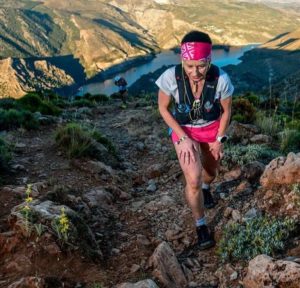 I was recently sitting under an olive tree, watching the sunrise in the South of Spain. It was just a couple of days after setting a personal record for a half marathon. I thought about how different surfaces may impact on my fitness level. So I did a little research when I got back home.
I was recently sitting under an olive tree, watching the sunrise in the South of Spain. It was just a couple of days after setting a personal record for a half marathon. I thought about how different surfaces may impact on my fitness level. So I did a little research when I got back home.
Is it harder to run on trails? The activity of running on trails is more tiring than running on pavement. Changes in elevation and uneven, varied trail surfaces all kill your momentum and slow you down.
The vast majority of runners are out pounding the pavement as it is the easier option in terms of effort. At the same time, almost everyone I have ever asked has said that they want to become a better and stronger runner. So surely there is a limit to how much better and stronger you can get by just choosing the easiest running surface. Let’s unpack all of this in a whole lot more detail.
Lack of Momentum Makes Running on Trails Hard
The key factor that makes running on a paved surface easier is that you have momentum. Each foot strike merely transfers enough energy to maintain the speed and momentum that you already have.
Firstly you have steep changes in elevation. Add to that the softer, uneven surface kills your rhythm and slows you down. Every time the trail slows you down you need to add effort to regain your speed. These repeated bursts of effort will eventually add up.
These same factors reduce the impact on your body and shorten recovery time so you can run more often without injury.
Hills – The single hardest Part of Any Run
Hills are the first things that runners think about when comparing trail running to road running in terms of physical difficulty. It takes very little imagination to visualize why.
The hills you find in a road race are mostly short and gentle. While the hills out on the trail are often brutally steep and very uneven.
From my own experience coping with hills when I run on a paved surface involves a slightly shorter stride, higher knee action, a more pronounced elbow pull back and maintaining an even breath pattern. Most of the time I am able to do these things and maintain good running form all the way up and over the hill.
Downhill on a paved surface is equally simple. I keep my elbows up and wide for balance. Then I just relax into a fast leg turnover and allow gravity to do the work.
On the trails, it is a completely different story, certainly for me. Because most trail hills are so much steeper and more technical there is no way I can maintain any sort of pace up a hill longer than a couple of hundred yards. Whenever I try, my heart rate shoots up above lactate threshold and I am gasping for breath. That continues and I stagger over the top and down the other side.
What works better for me is power hiking the hill, hands on my knees for more power so that I can run the crest and down the other side. It is way more effective overall.
Downhill running on a technical trail requires practice to avoid face planting. The confidence you gain carries over to road races where you can bomb the downhills without fear of falling.
Gravel – The Preferred Training surface for Elite Champions
Gravel is the surface that most closely resembles a paved road and for this reason, I rate gravel as the easiest trail surface to run on. Professional triathletes and North African distance runners do most of their training volume on gravel.
For starters an even gravel surface allows you to easily use your road shoes. The only drawback that I have found comparing a gravel surface in my road shoes with a paved surface is the reduced traction. So as long as I don’t try any drastic direction changes or sudden stops I don’t have any problems.
Dirt Is Everywhere – No Escaping This Trail Surface
This is by far the most common trail surface that I run on. There are a couple of factors that make running on dirt trails harder than running on pavement.
Dirt trails tend to be narrower and have protruding tree roots and rocks. As a result, you need to make sure that you clear these obstacles on each stride. More than once I haven’t managed that and have the scars on my shins and knees to show for it.
The next factor is that dirt trails tend to have twists and turns – often sharp turns. All of these break up your rhythm and momentum.
Finally, dirt trails are softer so you need to use more force with each stride in order to produce the same amount of speed.
Grass – The Soft Stuff We Ran On As Kids
Similar to dirt, grass trails are also soft and spongy underfoot. As a result, the surface absorbs a fair amount of the thrust generated with each step.
When I was in junior school I did almost all of my running on grass, barefoot. That taught me to improve my running form from an early age.
Sand – The Hell Part of Hell Week for US Marines
For me running on sand, especially soft sand was a massive learning curve. For the longest time, I would just get bogged down in the sand. Running on sand would just destroy power in my legs.
There is no doubt that running on sand is a lot harder than running on pavement.
It was only six years ago that I learned a trick to running faster in soft sand. It didn’t make running on sand any easier, just faster. It involves running with short strides and pointy toes, maintaining a forward lean.
Snow – Energy Sapping Leg Killer
Out of all the possible surfaces for a trail, snow is the one that I have almost no experience. For sure though snow, especially soft powder snow is a slog to run through. A Canadian friend told me that running a mile on soft powder snow is at least as hard as running two miles on the pavement.
That makes running on snow similar to running on soft sand in terms of physical difficulty.
One big difference between snow and sand is in terms of traction. If you run on a part of the trail where there is just a thin layer of snow on the ground you will very likely end up on a patch of ice, and have zero traction.
By far the best option is to run nearer the edge of the trail where the snow is thicker and crunchier where your trail shoes can get some grip. If the trail has a drop-off or a cliff be sure to maintain a safe distance from the edge when conditions are icy.
This season I plan to do a lot more snow and ice running on the mountain trails. Just yesterday I ordered these clip-on ice cleats for my trail shoes from Amazon. We’ll see how well they work on the super rocky high altitude trails.
Rocks – Precise Foot Placement is Key
Rocks are harder to run on in more ways than one, let me explain what happened to me…
When I run on pavement I am able to put on some tunes, kind of zone out and just go. I tried that running on a rocky trail once and only once. As you can imagine the outcome was not optimal.
I misjudged the space between two rocks and tripped. It took a further four or five strides to completely lose control and fall, hard. Besides ripping my favorite pair of well-worn running shorts, I impacted another rock four inches below my right armpit. Running with cracked ribs is no fun at all.
Born to Run on Trails
When researching his book Born to Run, Christopher McDougall spent time with the super athletes of the Tarahumara tribe.
Naturally these runners never had any access to paved roads and as a result, only ever run on trails. The realization was that these runners were way stronger than runners who routinely run on pavement. The reason is simple. Because running on trails is harder than paved roads, trails will mold you into a stronger runner.
Related Questions
Is trail running better than road running? So we know that trail running is harder than road running but is it better? From my perspective, I would say absolutely yes.
All of the factors that make trail running harder also make it more varied and interesting than road running. Add to that the smells and sounds of nature are so much better than traffic.
Why is trail running so good for you? Most of the factors that make trail running harder, also reduce impact forces and resulting injury.
